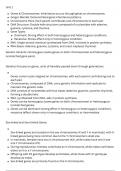Summary
Summary - PYC 1512
- Course
- Institution
Study notes for PYC1512 that will guarantee a 80% + on your next exam. These study notes have helped me so much when I wrote the exam and I hope it will help you to. This is perfect if your a bit behind on learning work and need a quick fix for the night before.
[Show more]




